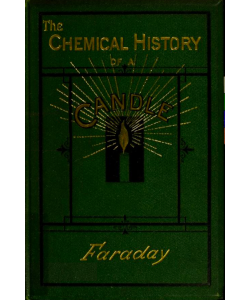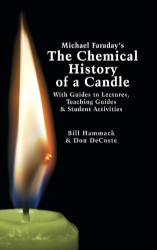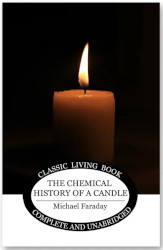The Chemical History of a Candle

1894 edition
Author:
Michael Faraday
Illustrator:
Author Unknown
Editor:
William Crookes
Publication:
1861 by Chatto & Windus (UK)
Genre:
Non-fiction, Science
Pages:
226
Current state:
This book has been evaluated and information added. It has been read and any content considerations have been added.
Book Guide
Search for this book used on:
Written by the renowned scientist Michael Faraday, this classic work offers a detailed examination of the chemical reactions that occur when a candle is burned, and how these reactions relate to the larger principles of physics and chemistry.
Faraday’s clear and engaging prose makes this book a pleasure to read, and his passion for science shines through on every page.
From Living Book Press reprint
From the primitive pine-torch to the paraffin candle, how wide an interval! between them how vast a contrast! The means adopted by man to illuminate his home at night, stamp at once his position in the scale of civilisation. The fluid bitumen of the far East, blazing in rude vessels of baked earth; the Etruscan lamp, exquisite in form, yet ill adapted to its office; the whale, seal, or bear fat, filling the hut of the Esquimaux or Lap with odour rather than light; the huge wax candle on the glittering altar, the range of gas lamps in our streets,—all have their stories to tell. All, if they could speak (and, after their own manner, they can); might warm our hearts in telling, how they have ministered to mans comfort, love of home, toil, and devotion.
Surely, among the millions of fire-worshippers and fire-users who have passed away in earlier ages, some have pondered over the mystery of fire; perhaps some clear minds have guessed shrewdly near the truth. Think of the time man has lived in hopeless ignorance: think that only during a period which might be spanned by the life of one man, has the truth been known.
Atom by atom, link by link, has the reasoning chain been forged. Some links, too quickly and too slightly made, have given way, and been replaced by better work; but now the great phenomena are known—the outline is correctly and firmly drawn—cunning artists are filling in the rest, and the child who masters these Lectures knows more of fire than Aristotle did.
The candle itself is now made to light up the dark places of nature; the blowpipe and the prism are adding to our knowledge of the earth’s crust; but the torch must come first.
Among the readers of this book some few may devote themselves to increasing the stores of knowledge: the Lamp of Science must burn. "Alere flammam."
W. Crookes, Preface
To view an example page please sign in.




